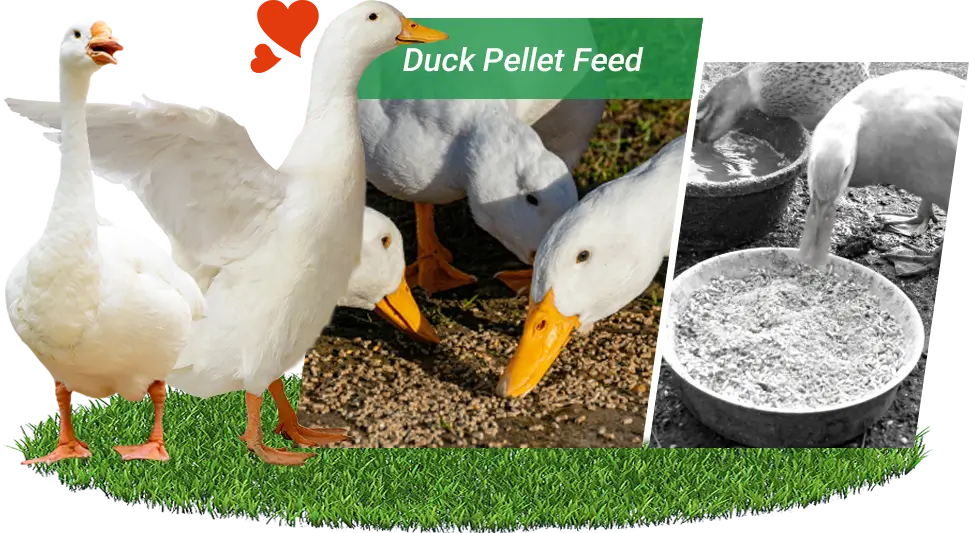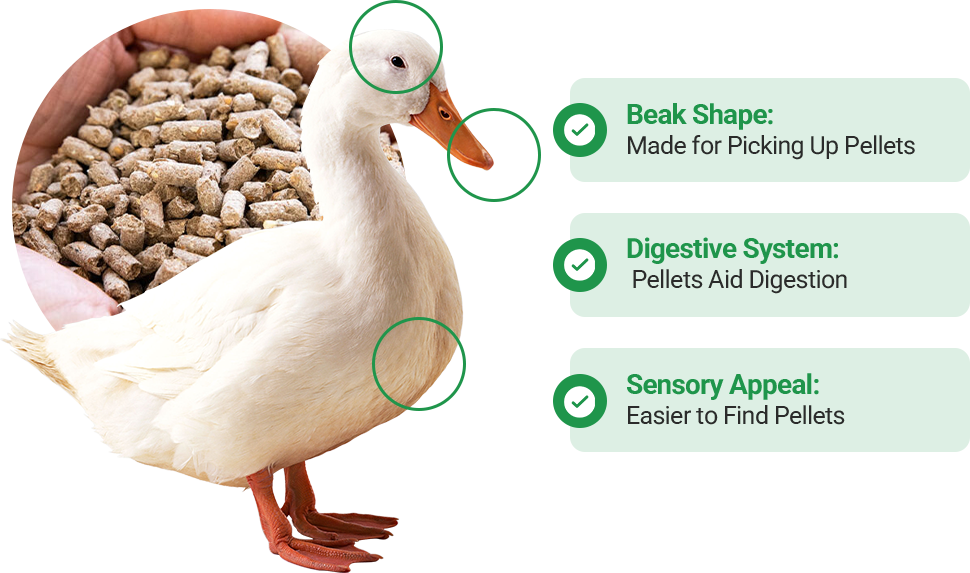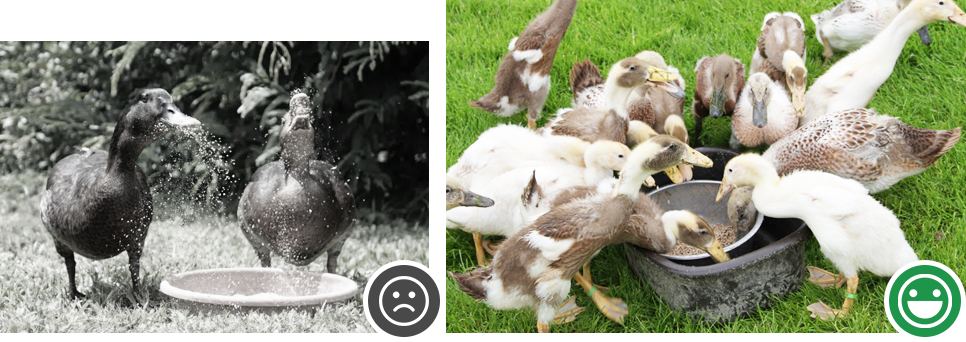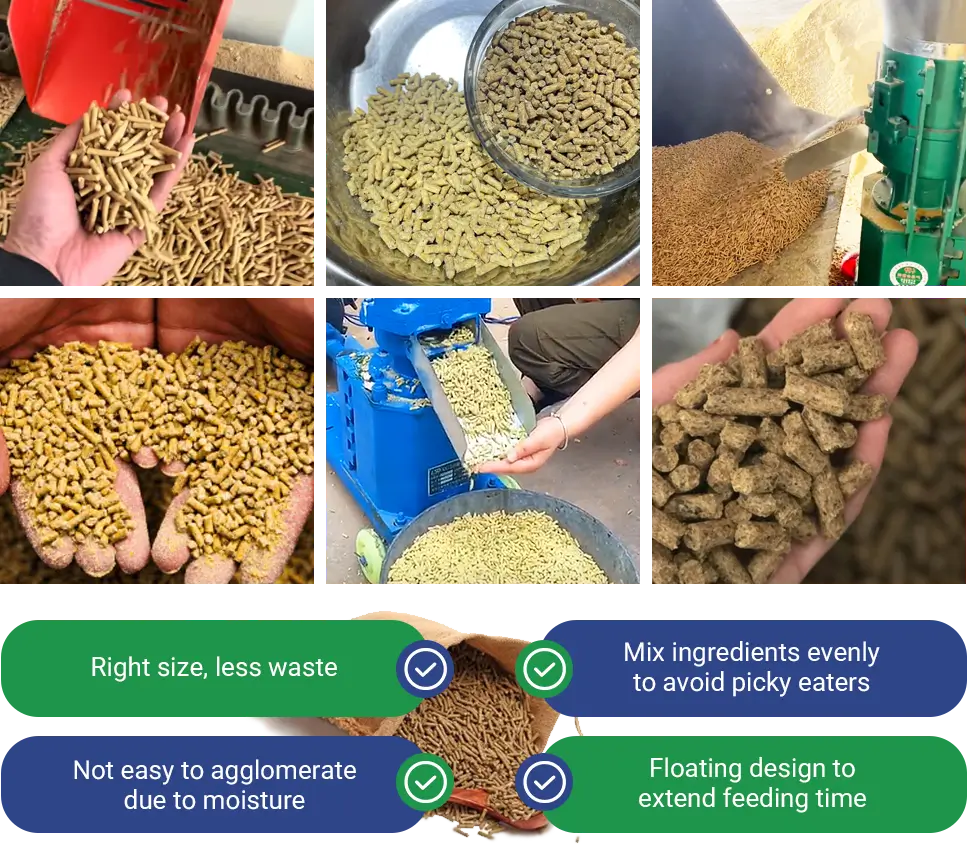The Secret: Why Ducks Prefer Pellet Feed
Have you noticed how ducks get super excited when you feed them pellets? The moment you scatter them, they rush over and eat quickly and neatly. But when it's mash, they lose interest - they eat slowly, pick through it, and end up wasting quite a bit. Are they just being picky? Let's talk about why ducks seem to prefer pellet feed.

A Natural Fit for Their Bodies
Ducks prefer pellet feed largely because it matches their physical structure and natural feeding habits. Here's why pellets work better for them:
Beak Shape: Made for Picking Up Pellets
A duck's beak is flat and wide, with tiny ridges along the edges-perfect for picking up small, solid bits like insects, seeds, or pellets. Pellets are just the right size and texture for their feeding style. Mash feed, on the other hand, tends to scatter, stick to their beak, or blow away, making it harder to eat.
Digestive System: Pellets Aid Digestion
Since ducks don't have teeth, they rely on their gizzard (a muscular part of the stomach) and small stones they swallow to grind food. Pellets are firm enough to activate the gizzard, helping with digestion. Fine mash may pass through too quickly, reducing grinding and nutrient absorption.
Sensory Appeal: Easier to Find Pellets
Ducks are drawn to things they can see and smell. Pellets stand out more on the ground or in water, while mash can sink or mix with dirt. Plus, the heat during pellet processing brings out a roasted aroma that ducks find appetizing.

Eating Habits and Preferences
It's not just about body structure-ducks like pellets because they suit the way they naturally eat. They're not just food-they make mealtime more fun and instinctive.
Triggers the Natural Pecking Instinct
Ducks are born foragers. They love to walk around, search, and peck as they go. Duck food pellets have the right size and solid, 3D shape-just like the bugs, seeds, or bits of water plants they'd find in nature. It sparks their instinct to "search-catch-eat." Mash, on the other hand, is too fine and scattered, with no clear shape. It's just not that interesting to them, and they eat it more passively.
More Satisfying to Chew
Pellets are firm enough to give ducks a bit of crunch as they eat-you can even hear the little "crack crack" sounds. This texture gives them a sense of chewing satisfaction. Just like we enjoy crispy snacks, ducks seem to enjoy the crunch, making them eat more actively and for longer. Mash is too soft, melts in the mouth, and doesn't offer the same chewing feel. It's just not as appealing.
Group Feeding and Competition
Ducks tend to follow each other and compete when they eat. When you scatter pellets, they roll and move on the ground, catching the ducks' attention right away. That movement often triggers a group rush-one duck starts eating, and others join in. It creates a "you eat, I eat" vibe that boosts feeding efficiency. Mash doesn't move, smells plain, and lacks stimulation, so it doesn't get the same reaction.

3 Key Advantages of Pellet Feed
Ducks love pellet feed not just because of its taste, but because it brings real benefits during daily farming. It's more efficient, more consistent, and easier to manage. Here's how:
- Ducks eat more actively, and there's less feed waste
- Balanced nutrition in every bite-less picky eating
- Easier to store, transport, and feed
Pellets are great, but they're not the only option. Depending on the stage or setup, mixing in some mash or crumble feed-plus a bit of corn, wheat, soybean meal, or rice bran-can work even better. Here's what I recommend for each stage:
| Stage | Recommended Feed | Suggested Size |
| Ducklings (1–14 days) | Mostly mash | 1.0–2.0 mm |
| Grower stage (15–35 days) | Medium pellets + some crumbles | 2.5–3.5 mm |
| Fattening stage (36+ days) | Mainly pellets | 3.5–4.5 mm |
| Stress or recovery periods | Mix of mash and small pellets | ≤ 2.5 mm |

Turns Out, Ducks Do Prefer Pellets
To see if ducks truly prefer pellet feed, we ran a 42-day trial comparing how ducks responded to mash versus pellets during feeding.
Experiment Setup
We selected 200 meat ducklings with similar starting weights and randomly divided them into two groups of 100 each.
Both groups were raised under the same conditions-temperature, humidity, lighting, and ventilation were kept consistent. Each day, we recorded feed intake, body weight, and feed consumption, while also monitoring their health and any signs of illness.
Experiment Results
| Indicator | Pellet Feed Group | Mash Feed Group |
| Avg. daily feed intake (g/bird) | 160 | 145 |
| Avg. daily weight gain (g/bird) | 65 | 55 |
| Feed conversion ratio (FCR) | 2.46 | 2.64 |
| Breathing problems (%) | 2 | 6 |
| Mortality rate (%) | 1 | 3 |
Note: FCR (Feed Conversion Ratio) shows how many kilos of feed are needed for each kilo of weight gain. A lower FCR means better efficiency.
Conclusion
This 42-day trial clearly shows that compared to mash, pellet feed helped ducks eat more, grow faster, stay healthier, and had a lower death rate. For farmers, pellet feed is clearly the best feed for ducks.
In short, ducks prefer pellet feed isn't just a coincidence, it's rooted in their body structure and natural eating habits. Choosing the right feed means ducks eat better, grow faster, and for farmers, it also means less waste, lower costs, and better results.
If you're thinking about making your own feed or want help choosing the right pellet solution for each stage of duck farming, feel free to reach out to us. We're here to help.

 Online Contact
Online Contact Send Message
Send Message
Need Some Help?
Contact us quickly and we will reply you within 24 hours. We will not disclose your information.